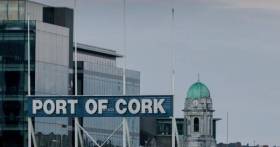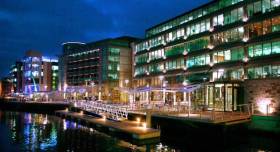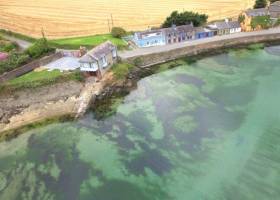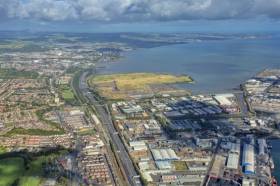Displaying items by tag: waterfront property
Homes By The Water Theme of New TG4 Series
“Views of the sea affect our soul”, and Irish people are drawn to coastal houses in spite of climate change factors, a new TG4 maritime television series finds.
'Tithe Cois Uisce' is an eight-part series that follows on from the popular "Tithe Cois Farraige' series.
Starting next Wednesday, January 17th, presenter Síle Nic Chonaonaigh will visit a different location to meet those who have built houses by the water.
In the first episode, Nic Chonaonaigh visits artist Donnacha Quilty on the outskirts of Galway city, Tracey Jeffrey of Tracey's Farmhouse Kitchen in Newtownards, Co Down and masseuse Veronica Lydon in Letterard, Co. Galway. All three people explain how they use the water as inspiration for their craft.
Coastal, island and inland locations are covered in the series, which begins on TG4 on Wednesday January 17th at 8.30pm and on the TG4 Player.
At the entrance to Cork city is the iconic Port of Cork sign which should be retained when the site is redeveloped the Green Party has said.
A planning application, reports EchoLive.ie, has been lodged for Ireland's tallest building located at the Port of Cork buildings at Custom House Quay.
Tower Holdings are proposing a 34-storey skyscraper hotel that would reach approximately 140m in height.
If approved and constructed, it would become Ireland’s tallest building by a significant margin, outstripping the current tallest building, the 79m-high Capital Dock in Dublin.
The €140m project will also include retail units, cultural spaces, food and beverage businesses, office space, recreational areas, and a micro-distillery, which the developer says could create up to 800 jobs.
Below the hotel, the Bonded Warehouses will be occupied by a range of uses to complement the hotel including retail, restaurants, cafes, and gallery and cultural spaces, with a public promenade wrapping around the entire site.
The proposed distillery would be located at the tip of the site where both the north and south channels of the river Lee meet.
More on this story here.
Dublin Gazette writes, that the Bulloch Harbour Preservation Association has announced it has begun fundraising to file for a judicial review of An Bord Pleanala’s (ABP) decision to grant planning permission for a property development on Bulloch Harbour.
Earlier this month ABP granted permission to Bartra Capital Property Group to build three, three storey villas, two apartments as well as number of other buildings such as a café on the iconic south Dublin harbour.
At the time of the decision, Bartra CEO Mike Flannery said this “marks a positive day for Bulloch Harbour and Bartra looks forward to enhancing the environs of Bulloch Harbour on the back of this decision.”
However, local residents who have opposed the development since Bartra originally submitted its proposals have announced they will be attempting to file for a judicial review of the granted planning permission.
In a statement, the association said: “We have been inundated with communications by the members of the public expressing their amazement, disbelief and outrage at the findings of ABP.
For more on this coastal development click here.
Cork 'City Quarter' Boardwalk In €14m Deal
#CityQuarter - In a deal worth up to €14m writes The Irish Examiner, is to be signed in the coming days on a remaining investment — including the Boardwalk bar and restaurant — at Cork city’s seminal City Quarter.
It went to market for Nama in September 2016, guiding €14.5 million.
The investment offer, including remaining 38,000 sq ft of offices, basement car parking and ground floor space at the €100m City Quarter, is close to being bought in one single lot, according to sources. It has an income of €654,000 with scope to double that to €1.33m, according to Savills.
It’s understood that one investor is behind the impending deal, and when concluded, it may involve a re-sale or sub-sale as well as leases of several of the key components.
Click here for more on the deal at the site which Afloat adds is directly opposite to Ardmore Shipping Corporation's 'Irish' office on Albert Quay.
The Bermuda headquartered corporation of a product/chemical tanker fleet, relocated last summer its principle operating office to Cork City from the suburb of Mahon downriver.
Last month several key appointments were made by Ardmore to their offices in Singapore and Houston, USA.
First Floating Hotel for Ireland Planned for Cork Quayside
#CorkFloatel -The first floating hotel and restaurant in Ireland writes the Evening Echo is being planned for Cork's city centre quays.
The backers of the project have secured a 100-metre luxury cruise vessel that they plan to permanently moor at Penrose Quay near the Custom House and operate as a four-star hotel.
The €1.75m ship ‘My Story’ is 105 metres long and has 87 cabins, three decks, lounge areas, a large restaurant and sun deck. It previously operated on the River Rhine.
The floating vessel would be moored adjacent to Michael Collins Bridge, and modifications will also be made to the quay wall to provide gangway access.
The backers of the project Sick & Sore Limited said the vessel would enhance the leisure amenities of Cork. Based in Dublin, the company is headed by Sam Corbett, who has been involved in many maritime projects around Ireland.
He was a key part of the project to acquire the former Cork-based tender vessel the Cill Áirne, renovating and refitting it for use as a restaurant on Dublin’s North Wall Quay.
Mr Corbett told the Evening Echo the project has the backing of a major tourism and accommodation operator.
For more on this development, click here.
Sutton’s Old Coastguard Station Transformed Into Home Of The Future
#WaterfrontProperty - Sutton’s former coastguard station has been utterly transformed into a fashionable home for the future, as The Irish Times reports.
Nadia and Mack Lennon purchased 1 Martello Terrace in the North Co Dublin suburb in 2014 and since then have overseen its conversion from a virtual museum of the area’s coastal heritage — as maintained by its previous owner, a pillar of the sailing community — to a modern open-plan family home.
Yet even as the Lennons use terms like “nostalgic coastal” and “bourgeois eclectic” to describe their vision, the house — now on the market for €995,000 through Gallagher Quigley — retains a number of its original features, as well as some rescued from other parts of coastal Dublin.
The Irish Times has much more on the story HERE.
Roberts Cove Coastguard House Now On The Market
#RobertsCove - Less than half a million is the asking price for the old coastguard station at Roberts Cove in Co Cork, as the Irish Examiner reports.
Situated on the scenic stretch between Cork Harbour and Kinsale, the Roberts Cove house has a history stretching back almost 200 years to the end of the Napoleonic Wars.
Part of the first phase of coastguard stations installed around the Irish coast by the British Empire, Roberts Cove is one of the finest examples of its era, coming with its own private slipway and even a small beach.
Though long since decommissioned, the waterfront property retains its boathouse and access to the Celtic Sea along with the many interior renovations made by its current owner to make it a comfortable seaside residence – and comes with potential for further expansion and improvement.
The Irish Examiner has much more on the story HERE.
#BelfastLough - Giant's Park on the North Foreshore of Belfast Lough is set to be the location of a new film studio, according to BBC News.
The circa £14 million development aims to capitalise on Northern Ireland's increasing popularity as a filming location for hit TV series like Game of Thrones and films such as the Brad Pitt-produced The Lost City of Z.
Belfast City Council heard that hundreds of jobs could be created in the construction and operation of the studio, earmarked for the former landfill waterfront site.
In other news, a 19th-century chapel overlooking Giant's Park with stunning views over Belfast Lough is on the market as part of a 'unique' residential development.
Built by the third Marquis of Donegall in the mid-1800s, the former Chapel of the Resurrection was extensively renovated in the 1980s and is now part of a package of zoned housing lands in a very desirable part of North Belfast, as the Belfast Telegraph reports.
€35m Plan for 1,000 Jobs in Wexford May Include New Marina
#NewMarina? Wexford County Council’s Chief Executive, Tom Enright has revealed ambitious plans for a €35 million development that may include a new marina along the town’s iconic Trinity Wharf site.
According to the Wexford People, the county council, which recently bought the site from NAMA for €800,000, a 10th of its value a decade ago, is planning to establish a high-quality business park there, creating at least 1,000 new jobs. Asides the possibility of a marina the development facilities are for a 'modest' hotel, restaurants, cafes, pubs, residential units and a public park.
The project will be a 'less dense' and more jobs friendly version of the development than the Celtic Tiger project that years ago had been planned for the 10-acre brownfield site by business magnate Derry McPhilips, but which never came to fruition.
To read more including a €2 million revamp which is due to connect more the existing quays to the town's main street via a new boardwalk, click here.
Green Business Hub For Belfast Lough Foreshore
#BelfastLough - Belfast Lough's north foreshore will soon be home to a concentration of sustainable businesses that promises to be a first for Northern Ireland.
UTV News reports on the Cleantech Hub, a 30-acre waterfront site at Giant's Park aimed at firms in the renewables, environmental and low-carbon sectors.
Already adjacent to the site is a plant that converts gas from landfill to electricity powering 2,500 homes.
And it's hoped that the new scheme "will now firmly position the city as a leading destination for green technology, enhancing the profile of the sector here, as well as generating interest beyond these shores," according to David McNellis of agents Lisney, managing the hub on behalf of Belfast City Council.
UTV News has more on the story HERE.


































































